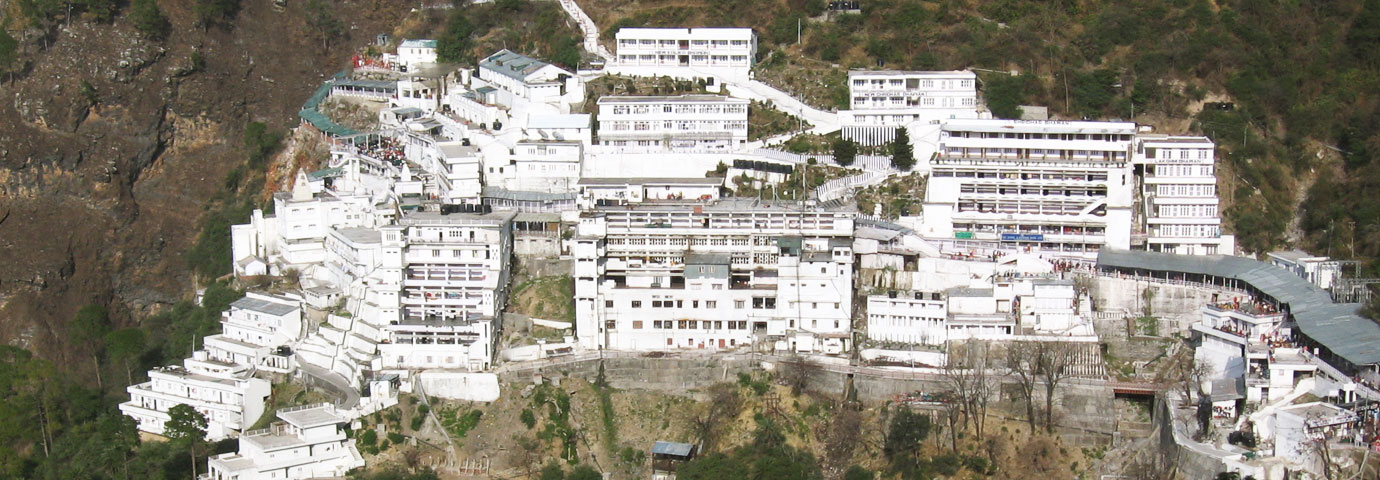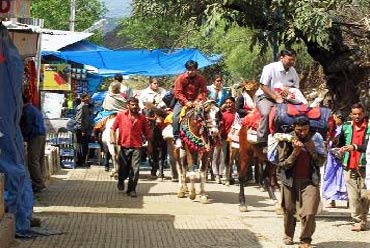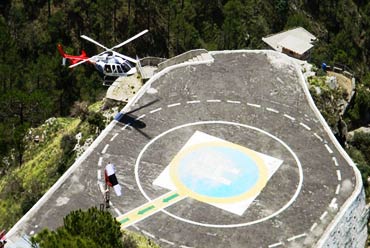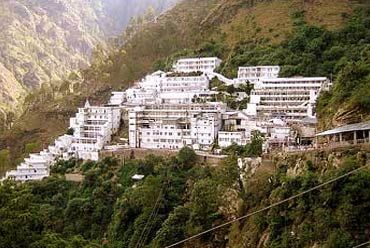Since times immemorial, thousands of pilgrims every year have been visiting the Hindu pilgrimage of Vaishno Devi from all corners of the globe. Considered to be one of the holiest Hindu pilgrimage in North India, the cave is the abode of the Mother Goddess, who is worshipped here in the forms of Maha Kali, Maha Saraswati, and Maha Lakshmi. As the Goddess welcomes her devotees every day, the number of pilgrims in this hindu pilgrimage keeps on swelling year after year. Vaishno Devi is not merely a hindu pilgrimage; it is a site of spiritual cleansing and resuscitation for the heart that truly seeks the divine.
Location
The Vaishno Devi hindu pilgrimage is nestled in the Trikuta Mountain. It lies 61 km north of Jammu in the northern state of Jammu and Kashmir. Perched at a height of 5,200 feet above the sea level, Vaishno Devi is a cave in the lower Himalayas. Katra, the town at the foot of the Trikuta hills is the base camp for the Vaishno Devi shrine. Katra is 48 km from Jammu, 650 km from Delhi (via Una), 520 km from Udhampur, 410 km from Chandigarh and 80 km from Patnitop The shrine is visited all through the year, but the path is difficult during the winters when the route is often blocked by snowfall.
History
The legend goes that more than 700 years ago, Vaishno Devi, a devotee of Lord Vishnu, used to pray to Lord Rama and had taken vow of celibacy. One day, Bhairon Nath, a demon-God, saw her and gave chase. The Goddess felt thirsty at Banganga and shot an arrow into the earth from where water gushed out. Charan Paduka, marked by the imprints of her feet, is the place where she rested. She then meditated in the cave at Ardhkanwari. It took Bhairon Nath nine months to locate her. Mata Vaishno Devi then blasted an opening at the other end of the cave. She assumed the form of Maha Kali and cut off Bhairon Nath's head, which fell at the place where the Bhairon Temple is now located. The boulder at the mouth of the holy cave, according to the legend, is the petrified torso of Bhairon Nath who was granted divine forgiveness by the benevolent Mata in his dying moments.
Tourists Attractions - The Shrine
The holy cave shrine of Vaishno Devi is said to have been built by the five Pandavas. The length of the cave is about 98 ft. The symbols of a large number of gods and goddesses of the Hindu pantheon can be seen here. At the mouth of the original tunnel to the holy cave can be seen the symbols of Vakra Tunda Ganesha, Surya Dev and Chandra Dev. When one crawls into the cave through the tunnel, he/she crosses over the Dhadh of Bhairon Nath. The symbol of Lord Hanuman, called Launkra Beer, can also be seen and the pilgrims have to wade through water beyond the Launkra Beer point. Twenty-three feet beyond Launkra Beer, on the upper left-hand side, the roof of the cave flares out and the weight of this overhang appears to be resting on the innumerable heads of Shesh Nag. Immediately below Shesh Nag can be seen the symbols of Shankh, Chakra, Gada and Padam. Higher up, almost touching the ceiling of the cave, are the symbols of the five Pandavas, the Sapt Rishi, the udders of the divine cow, Kamadhenu, Brahma, Vishnu, Shiva and Parvati.
Places Around Vaishno Devi
The Deva Mai temple is about three miles short of Katra town. Many devotees treat it as a very holy site and go there to perform paeans.The Holy Cave of Shiv Khori is the abode of Lord Shiva, situated at a distance of 70 km from Katra. The cave is a real wonder to be seen and measures nearly a kilometer in length with a four-feet-high naturally formed Shiv-lingam at the heart of the sanctum sanctorum.A few miles away from Katra is Pindian at the foot of the Trikuta range. This spot is also dedicated to Vaishno Devi.
The temple of Baba Dhansar is dedicated to Lord Shiva and is located at a distance of about 15 km from Katra on way to Salal Dam. Here, a huge spring emerges from the rocks in a thick grove of trees and forms a number of small rapids before flowing into the holy rivulet that merges with the Chenab River.
The sacred shrine of Dera Baba Banda is situated at a distance of 30 km from Katra. It is a major Hindu-Sikh pilgrimage center. According to local legend, Baba Banda Bairaagi was Guru Gobind Singh's favorite 'Saint Soldier' who constructed a Gurdwara on the banks of river Chenab, where he spent his last days.The legendary hero Baba Jitto's temple is situated at village Aghar Jitto, which is just 5 km from Katra town, on the Katra-Reasi Road. Baba Jitto, who was a peasant by profession, was a staunch devotee of the Goddess Vaishno Devi. He is remembered amongst the peasant class for his revolutionary act of opposing the landlord's oppression and subsequently laying down his life for this cause. A big fair called 'Jhiri Mela' is still conducted to commemorate the martyrdom of Baba Jitto at a place called 'Jhiri', which is 20 km from Jammu.
How To Reach
By Road - Vaishno Devi Temple can be reached after making a steep 13-km trek from the road head at Katra, the town at the foot of the Trikuta hills. Several porters and ponies are available at Katra on hire.
By Air- Jammu is the nearest airport. Jammu's civil airport at Ranibagh is 9 km from the city center. Alliance Air, a subsidiary of Indian Airlines, runs flights to and from Delhi, Srinagar and Leh.
By Rail - Jammu is the nearest railhead, which lies on the other side of the Tawi River. Jammu is very well connected with all major destinations in India by rail. Direct express trains link it with Mumbai, Delhi and Calcutta.
Katra is connected with Tarn Taran, Amritsar, Jallandhar, Ludhiana, Patiala, Chandigarh, Delhi, Jwalaji and Srinagar by road. We would provide you all India tourist permit vehicles for the local transportations and also for the intercity drives too.





